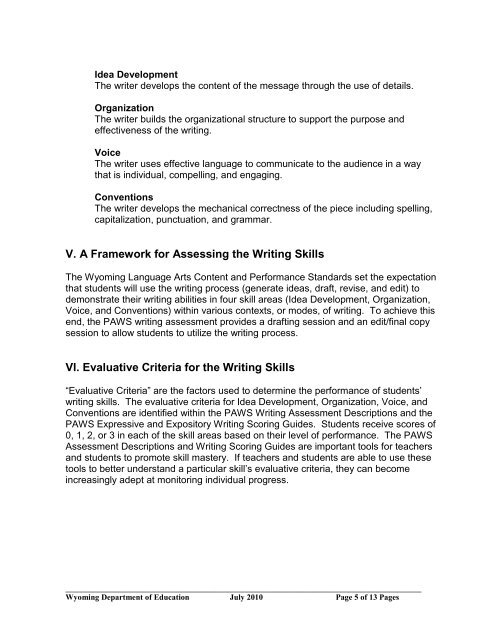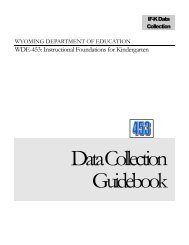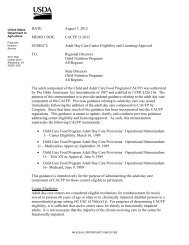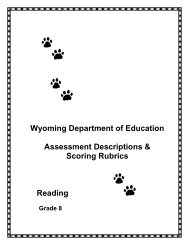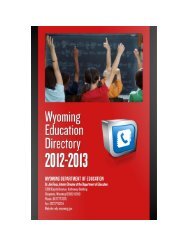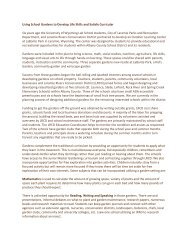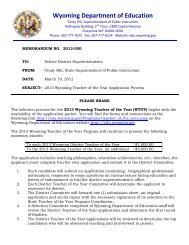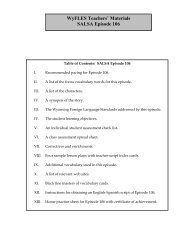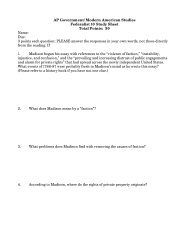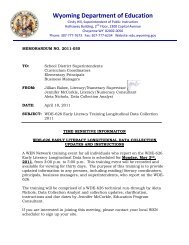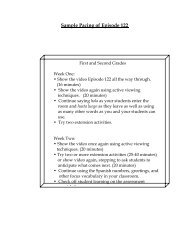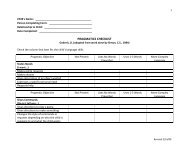Writing Assessment Descriptions-Writing Scoring Guide Grade 6
Writing Assessment Descriptions-Writing Scoring Guide Grade 6
Writing Assessment Descriptions-Writing Scoring Guide Grade 6
You also want an ePaper? Increase the reach of your titles
YUMPU automatically turns print PDFs into web optimized ePapers that Google loves.
Idea Development<br />
The writer develops the content of the message through the use of details.<br />
Organization<br />
The writer builds the organizational structure to support the purpose and<br />
effectiveness of the writing.<br />
Voice<br />
The writer uses effective language to communicate to the audience in a way<br />
that is individual, compelling, and engaging.<br />
Conventions<br />
The writer develops the mechanical correctness of the piece including spelling,<br />
capitalization, punctuation, and grammar.<br />
V. A Framework for Assessing the <strong>Writing</strong> Skills<br />
The Wyoming Language Arts Content and Performance Standards set the expectation<br />
that students will use the writing process (generate ideas, draft, revise, and edit) to<br />
demonstrate their writing abilities in four skill areas (Idea Development, Organization,<br />
Voice, and Conventions) within various contexts, or modes, of writing. To achieve this<br />
end, the PAWS writing assessment provides a drafting session and an edit/final copy<br />
session to allow students to utilize the writing process.<br />
VI. Evaluative Criteria for the <strong>Writing</strong> Skills<br />
“Evaluative Criteria” are the factors used to determine the performance of students’<br />
writing skills. The evaluative criteria for Idea Development, Organization, Voice, and<br />
Conventions are identified within the PAWS <strong>Writing</strong> <strong>Assessment</strong> <strong>Descriptions</strong> and the<br />
PAWS Expressive and Expository <strong>Writing</strong> <strong>Scoring</strong> <strong>Guide</strong>s. Students receive scores of<br />
0, 1, 2, or 3 in each of the skill areas based on their level of performance. The PAWS<br />
<strong>Assessment</strong> <strong>Descriptions</strong> and <strong>Writing</strong> <strong>Scoring</strong> <strong>Guide</strong>s are important tools for teachers<br />
and students to promote skill mastery. If teachers and students are able to use these<br />
tools to better understand a particular skill’s evaluative criteria, they can become<br />
increasingly adept at monitoring individual progress.<br />
________________________________________________________________________________________<br />
Wyoming Department of Education July 2010 Page 5 of 13 Pages


